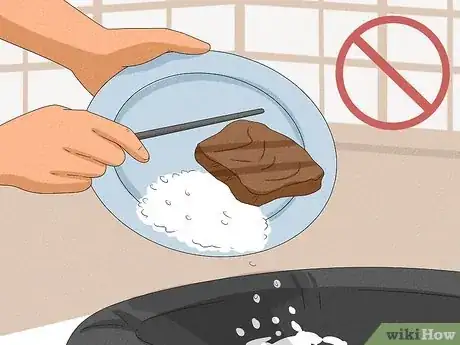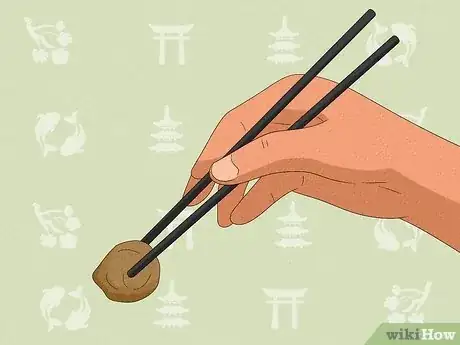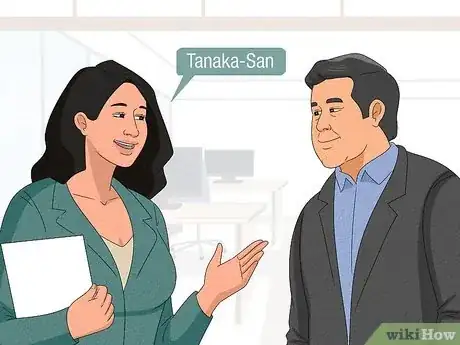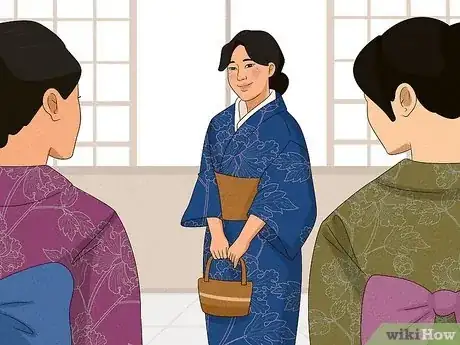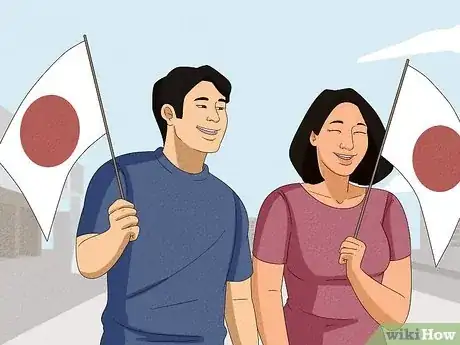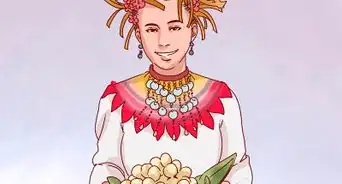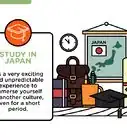X
wikiHow is a “wiki,” similar to Wikipedia, which means that many of our articles are co-written by multiple authors. To create this article, volunteer authors worked to edit and improve it over time.
There are 14 references cited in this article, which can be found at the bottom of the page.
This article has been viewed 1,125 times.
Learn more...
When many people think of Japanese culture, they think of kawaii, anime, and Kimonos. In reality, there is a lot more to Japanese culture than this. Japanese culture is unique and it is important to understand Japanese culture when taking a trip to Japan. Read on to learn more about the beauty that is Japanese culture.
Steps
Part 1
Part 1 of 4:
Following Japanese Etiquette
-
1Say "Itadakimasu" before eating a meal. The Japanese do this as a symbol of respect for their food, and all that went into making it. You normally say this before having a feast (before eating dinner, for example) but you can also say this before having breakfast or lunch, even before having a snack.
- Pronounce it 'ee-tah-dah-kee-mass. Remember that Japanese people do not pronounce "su" a the end of the word, shortening it to just "s".
- Put your hands in a clapping position and close your eyes while saying it. This gives a greater sign of respect for your food.
-
2Don't eat and walk at the same time. This is seen as disrespectful and is thus frowned upon in Japan.[1] This also applies to drinks. Instead, put your food in takeout bags to carry them. If you aren't finished yet but are full, you can store your food in the fridge for later.Advertisement
-
3Don't be wasteful. This is frowned upon in the west too, but it is especially discouraged in Japan. Throwing perfectly good things in the trash (this includes food, art supplies, paper, pretty much anything) is considered rude in Japan. Make sure to use up every last bit of your materials in Japan.
-
4Show respect to strangers and people who are older than you. You can do this by bowing, saying "please" and "thank you" (Kudasai (ください) and Arigato (ありがとう) in Japanese), and if you are speaking Japanese, you can use "Keigo" form. To use Keigo, you can simply add "Desu" or "Masu" to the end of the sentence.
- Use Masu for verbs and Desu for everything else.
-
5Slurp your food. While this may be considered rude in many cultures, in Japanese culture, it is considered a sign of appreciation for the chef's hard work in preparing the food along with a way to enhance the flavor and cool it down. Even if it may seem awkward, try slurping your noodles next time you visit a Japanese restaurant.
- Not slurping your food can be taken as rude and the people around you might think you hate the food and don’t appreciate the hard work that went into making the food.
Advertisement
Part 2
Part 2 of 4:
Eating Traditional Japanese Cuisine
-
1Understand how much the Japanese value their food. The Japanese take food very seriously. Food is often cooked to near perfection and is selected based on the season.[2] In Japan, food is often presented in small portions so you can truly enjoy the food's carefully selected flavors. Japanese chefs often include a variety of flavors in their meals.
-
2Use chopsticks. While you won't be using chopsticks for everything٫ it's important to learn how to use them. Forks and knives are only used for Western food٫ and chopsticks are used for all other food. Using chopsticks will require some practice٫ so maybe take some time to practice using them before taking your trip to Japan.
Advertisement
Part 3
Part 3 of 4:
Socializing with Japanese People
-
1Bow when you greet each other and when thanking them. When saying hello (Konnichiwa, こんにちは), when thanking someone (Arigatou, ありがとう) or when saying good morning to someone (Ohayou Gozaimasu おはようございます), bow to show your respect.
- Don't bow to friends, siblings, or people younger than you since bowing is done to show respect to other people.
-
2Speak in Keigo to strangers, clients at work, your boss, coworkers, and people older than you. This has been stated before, however, it is super important since not speaking in Keigo to these types of people is rude and is more often than not offensive. These people might get mad at you when you speak in non-Keigo. To avoid this, simply add Desu (です) or Masu (ます) at the end of the sentence.
- When asking a question in Keigo, add Ka (か) to the end of the sentence. Make sure to also include "Desu" or "Masu". Example: "メニューを頂けますか?", "Menyū o itadakemasu ka?", "Can I have the menu?" In English.
-
3Don't address the person you're talking to as "you". This is considered rude in Japanese culture and may offend some people. Instead, address them as [Their Name] + San. Example: If the person's name is Tanaka, address them as "Tanaka-San".
- If you don't know their name, ask them "おなまえはですか?" (O namae wa desu ka?), "What's your name?" In English.
Advertisement
Part 4
Part 4 of 4:
Celebrating Japanese Holidays
-
1Celebrate the Japanese New Year on January 1st. Japan doesn't celebrate the Lunar New Year. It mostly celebrates the Gregorian calendar's January 1st New Year instead. This happened after the Meiji Restoration, when Japan switched from the old lunar calendar to the Western, "more modernized" Gregorian calendar. [3]
- Otoshidama (お年玉) is a tradition celebrated on Japanese New Year where adults give money to children. How much money is given depends on the child's age٫ but if there are multiple children the same amount is given to each child.[4]
- Fukubukuro (福袋) is another Japanese New Year tradition where many people buy Fukubukuro. Fukubukuro is a surprise bag that is sold at a different price depending on the retailer. Sometimes whats inside the bag is worth more than the actual price of the bag, but part of the risk is not knowing what’s inside.[5]
- Hatsumode (初詣) is one of the more traditional Japanese New Year customs. Hatsumode is where many people visit a shrine to pay their respects and to wish for a happy and healthy year. Shrines are often very crowded as a result of families all going together to pray at the shrines.[6]
-
2Celebrate Coming of Age Day (Sejin no hi٫ 成人の日) on the second Monday of January. This holiday honors people who will turn 20, which is the age of an adult. If you turn 20 between April 2nd of the previous year and April 1st of the next year, you will be one of the people celebrated. [7]
- Many women celebrate Coming of Age Day by wearing a Furisode, (振袖) a type of Kimono that features long sleeves and are the most formal type of Kimono.[8]
-
3Celebrate National Foundation Day (Kenkoku Kinen no Hi, 建国記念の日) on February 11. National Foundation Day celebrates the founding of Japan, which was enforced by a Cabinet Order set in 1966.[9] This is basically the country's national day, like July 4th in the U.S. and Bastille Day in France.
- Japan has a parade called the National Foundation Day Celebration Parade held on that day. It starts on 9:00 am and ends at 2:00 pm.[10]
Advertisement
Warnings
- Do NOT pass your food directly to someone else using chopsticks. This is done at funerals.⧼thumbs_response⧽
- Do not point with your chopsticks, wave them around, or play with them.⧼thumbs_response⧽
Advertisement
References
- ↑ https://theculturetrip.com/asia/japan/articles/11-etiquette-rules-you-should-know-before-traveling-to-japan/
- ↑ https://me.jtbcom.co.jp/newsletters/japanese-food-cuisine-in-culture.html
- ↑ https://guidable.co/culture/lunar-new-year-in-japan/
- ↑ https://en.m.wikipedia.org/wiki/Japanese_New_Year
- ↑ https://top.his-usa.com/destination-japan/blog/japanese_new_years_traditions.html
- ↑ https://top.his-usa.com/destination-japan/blog/japanese_new_years_traditions.html
- ↑ https://blog.japanwondertravel.com/coming-of-age-day-in-japan-30415
- ↑ https://en.m.wikipedia.org/wiki/Coming_of_Age_Day
- ↑ https://www.officeholidays.com/holidays/japan/japan-national-foundation-day
- ↑ https://en.m.wikipedia.org/wiki/National_Foundation_Day
- https://theculturetrip.com/asia/japan/articles/11-etiquette-rules-you-should-know-before-traveling-to-japan/
- https://me.jtbcom.co.jp/newsletters/japanese-food-cuisine-in-culture.html
- https://www.japan-guide.com/e/e2039.html
- https://top.his-usa.com/destination-japan/blog/japanese_new_years_traditions.html
- https://en.m.wikipedia.org/wiki/National_Foundation_Day
About This Article
Advertisement


